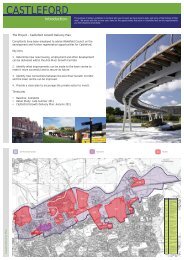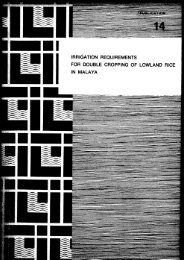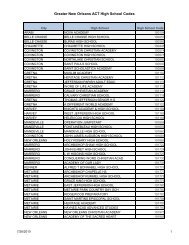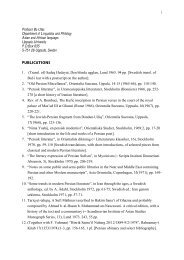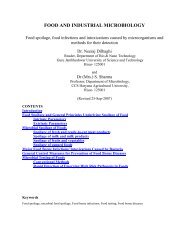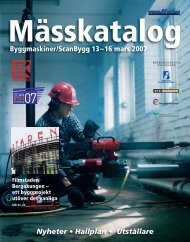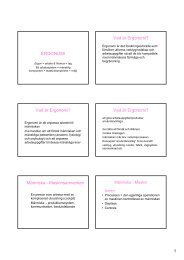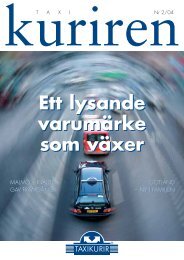Herbicides and Forest Vegetation Management - Penn State ...
Herbicides and Forest Vegetation Management - Penn State ...
Herbicides and Forest Vegetation Management - Penn State ...
Create successful ePaper yourself
Turn your PDF publications into a flip-book with our unique Google optimized e-Paper software.
<strong>Herbicides</strong> <strong>and</strong> <strong>Forest</strong><br />
<strong>Vegetation</strong> <strong>Management</strong><br />
Controlling Unwanted Trees, Brush, <strong>and</strong><br />
Other Competing <strong>Forest</strong> <strong>Vegetation</strong>
Prepared by David R. Jackson, extension<br />
educator, <strong>and</strong> James C. Finley, professor<br />
of forest resources.<br />
Photo Credits<br />
Howard Nuernberger, former photographer,<br />
Information <strong>and</strong> Communication<br />
Technologies, <strong>Penn</strong> <strong>State</strong> (all photos<br />
except those listed below)<br />
Mitchell Blair, vegetation management<br />
research specialist, Department of Plant<br />
<strong>and</strong> Soil Sciences, University of Kentucky<br />
(photo 20)<br />
Todd Hagenbuch, northeast chemicalsales<br />
representative, Alenza (photos 3,<br />
13, 14, 25, <strong>and</strong> 31)<br />
David Jackson (photos on front <strong>and</strong><br />
back cover, 1, 4, 5, 11, 12, 15, 16, 17,<br />
21, 22, 28, <strong>and</strong> 36)<br />
Mark Rice, forestry vegetation management<br />
specialist, DuPont (photo 19)<br />
Barry Rose, forester, <strong>Forest</strong> Regeneration<br />
Services (photo 32)<br />
Mike Santucci, service forester, Virginia<br />
Department of <strong>Forest</strong>ry (photo 33)<br />
<strong>Penn</strong> <strong>State</strong> College of Agricultural Sciences<br />
research <strong>and</strong> extension programs are funded<br />
in part by <strong>Penn</strong>sylvania counties, the Commonwealth<br />
of <strong>Penn</strong>sylvania, <strong>and</strong> the U.S.<br />
Department of Agriculture.<br />
Visit <strong>Penn</strong> <strong>State</strong> Extension on the Web:<br />
extension.psu.edu<br />
This publication is available from the Publications<br />
Distribution Center, The <strong>Penn</strong>sylvania<br />
<strong>State</strong> University, 112 Agricultural Administration<br />
Building, University Park, PA 16802. For<br />
information telephone 814-865-6713.<br />
Where trade names appear, no discrimination<br />
is intended, <strong>and</strong> no endorsement by the<br />
<strong>Penn</strong> <strong>State</strong> College of Agricultural Sciences is<br />
implied.<br />
This publication is available in alternative<br />
media on request.<br />
The <strong>Penn</strong>sylvania <strong>State</strong> University is committed<br />
to the policy that all persons shall have equal<br />
access to programs, facilities, admission, <strong>and</strong><br />
employment without regard to personal characteristics<br />
not related to ability, performance,<br />
or qualifications as determined by University<br />
policy or by state or federal authorities. It is the<br />
policy of the University to maintain an academic<br />
<strong>and</strong> work environment free of discrimination,<br />
including harassment. The <strong>Penn</strong>sylvania<br />
<strong>State</strong> University prohibits discrimination<br />
<strong>and</strong> harassment against any person because<br />
of age, ancestry, color, disability or h<strong>and</strong>icap,<br />
national origin, race, religious creed, sex, sexual<br />
orientation, gender identity, or veteran status.<br />
Discrimination or harassment against faculty,<br />
staff, or students will not be tolerated at The<br />
<strong>Penn</strong>sylvania <strong>State</strong> University. Direct all inquiries<br />
regarding the nondiscrimination policy to<br />
the Affirmative Action Director, The <strong>Penn</strong>sylvania<br />
<strong>State</strong> University, 328 Boucke Building,<br />
University Park, PA 16802-5901; Tel 814-865-<br />
4700/V, 814-863-1150/TTY.<br />
Produced by Ag Communications<br />
<strong>and</strong> Marketing<br />
© The <strong>Penn</strong>sylvania <strong>State</strong> University 2011<br />
CODE # UH174 Rev2.5M04/11colortech4738
Introduction<br />
There are a number of ways to manage<br />
vegetation: manual, mechanical,<br />
biological, cultural, <strong>and</strong> chemical. Integrated<br />
vegetation management (IVM)<br />
uses a combination of these techniques.<br />
This publication examines the use of<br />
herbicides to manage forest vegetation<br />
<strong>and</strong> attempts to set aside some misconceptions<br />
concerning herbicide use in<br />
forests. <strong>Forest</strong>ry labeled herbicides are<br />
effective <strong>and</strong> environmentally sound;<br />
however, their use remains controversial.<br />
Out of necessity, forest l<strong>and</strong>owners<br />
<strong>and</strong> resource managers are increasingly<br />
turning to herbicides for vegetation<br />
management.<br />
Many factors are increasing the need for<br />
vegetation management <strong>and</strong> the use of<br />
herbicides. These factors include vegetation<br />
that interferes with forest regeneration,<br />
poorly planned <strong>and</strong> executed<br />
timber harvesting practices, declining<br />
pulpwood markets, <strong>and</strong> increasing<br />
abundance of invasive plant species. Let<br />
us briefly examine each of these factors.<br />
1. Shade cast by dense fern understories inhibits seedling germination <strong>and</strong><br />
growth.<br />
3
Interfering vegetation consists of<br />
plants that inhibit the germination <strong>and</strong><br />
growth of seedlings by casting dense<br />
shade on the forest floor. Interfering<br />
plants benefit from specific light conditions<br />
<strong>and</strong> selective browsing preferences<br />
by deer that remove or reduce other<br />
plant competitors. Poorly planned <strong>and</strong><br />
executed timber harvests, known as<br />
“high grading,” leave behind trees with<br />
low commercial value. This has resulted<br />
in a shift toward less desirable tree<br />
species <strong>and</strong> poorer quality trees in our<br />
woodlots. With declining pulpwood<br />
markets, many overstocked st<strong>and</strong>s of<br />
trees that would benefit from thinning<br />
are not receiving treatment. Thinning<br />
improves tree growth <strong>and</strong> insect <strong>and</strong><br />
disease resistance. Lastly, the increasing<br />
abundance of invasive plants directly<br />
influences the ability of forests to retain<br />
native plant <strong>and</strong> wildlife diversity.<br />
<strong>Herbicides</strong>, when properly applied, can<br />
address all these issues safely, efficiently,<br />
<strong>and</strong> economically.<br />
<strong>Herbicides</strong> are a proven safe <strong>and</strong> effective<br />
method for managing forest vegetation<br />
<strong>and</strong> are appropriate for achieving<br />
many objectives, including regeneration<br />
establishment, increased timber production,<br />
enhanced wildlife habitat, non-<br />
native plant control, <strong>and</strong> road <strong>and</strong><br />
facility maintenance. When properly<br />
applied, herbicides can increase property<br />
value, productivity, aesthetics,<br />
<strong>and</strong> utility. However, underst<strong>and</strong> that<br />
choices exist. A well-developed <strong>and</strong> implemented<br />
integrated pest management<br />
plan will include alternative vegetation<br />
control approaches with <strong>and</strong> without<br />
the use of herbicides. This publication<br />
will help you identify the most efficient,<br />
environmentally sound, <strong>and</strong> cost-<br />
effective solution for addressing your<br />
forest vegetation management needs.<br />
4<br />
2. Poorly executed timber harvests often leave behind trees of low commercial<br />
value.<br />
3. Shady understory conditions <strong>and</strong> a low browsing preference by deer foster<br />
striped maple development.
4. Grasses can reduce regeneration potential by casting heavy shade <strong>and</strong><br />
providing cover for seed-eating small mammals.<br />
5. Mountain laurel <strong>and</strong> bracken fern form dense thickets that interfere with<br />
forest regeneration.<br />
5
6<br />
Choosing the Right <strong>Forest</strong>ry Herbicide <strong>and</strong><br />
Application Method<br />
No single herbicide, rate, or application<br />
method works for all vegetation management<br />
needs. Each situation requires<br />
advanced assessment to ensure that the<br />
lowest risk, most efficient, <strong>and</strong> most<br />
cost-effective control program is chosen.<br />
For a given situation the soil type,<br />
plant species, density, <strong>and</strong> size affect<br />
the herbicide prescription. Additional<br />
factors such as time of year <strong>and</strong> weather<br />
conditions are important because they<br />
affect plant growth, herbicide uptake,<br />
<strong>and</strong> translocation.<br />
Herbicide summaries can be found on<br />
<strong>Penn</strong> <strong>State</strong>’s <strong>Forest</strong> <strong>Vegetation</strong> <strong>Management</strong><br />
Web site at fvm.cas.psu.edu.<br />
The summaries will help you quickly<br />
compare herbicides commonly used<br />
in forestry <strong>and</strong> registered for use in<br />
<strong>Penn</strong>sylvania. They convey key points<br />
found on the product label <strong>and</strong> allow<br />
you to select those products best suited<br />
to your situation. Always carefully read<br />
<strong>and</strong> follow the product label directions,<br />
precautions, <strong>and</strong> restrictions before applying<br />
any pesticide.<br />
The first consideration when selecting<br />
an herbicide is the target plant’s<br />
location. Some examples of sites are<br />
rights-of-way, wildlife openings, forests,<br />
wetl<strong>and</strong>s, <strong>and</strong> industrial sites. The<br />
product label lists currently labeled<br />
6. Shrub honeysuckle (Lonicera spp.) <strong>and</strong> other invasive plants reduce native<br />
plant <strong>and</strong> wildlife diversity.
sites. Applying a pesticide to a site not<br />
listed on the label is illegal. The <strong>Forest</strong><br />
<strong>Vegetation</strong> <strong>Management</strong> Web site<br />
(fvm.cas.psu.edu) includes common<br />
herbicides currently labeled for forest<br />
sites in <strong>Penn</strong>sylvania.<br />
The Environmental Protection Agency<br />
(EPA) approves pesticide use <strong>and</strong><br />
establishes restrictions. Only certified<br />
applicators can apply “restricted use”<br />
pesticides. Restricted use pesticides have<br />
a prominently displayed statement on<br />
the product label (see “Specimen Label”<br />
below). The restricted use statement<br />
will often indicate why the product has<br />
received a restricted use status.<br />
Pesticides not containing the restricted<br />
use statement are referred to as “general<br />
use.” General use pesticides do not<br />
require applicator certification as long<br />
as the product is applied to property<br />
owned or rented by the applicator or<br />
their employer. Virtually all vegetation<br />
control in the forest involves the application<br />
of general use herbicides. This<br />
provides forest l<strong>and</strong>owners in <strong>Penn</strong>sylvania<br />
an opportunity to address vegetation<br />
management needs on their own<br />
properties without becoming certified.<br />
The necessity of safe herbicide h<strong>and</strong>ling<br />
<strong>and</strong> use carries with it the responsibility<br />
to read, underst<strong>and</strong>, <strong>and</strong> follow label<br />
directions.<br />
Product selectivity must be considered<br />
when choosing an appropriate herbicide.<br />
Selectivity refers to the resistance<br />
various classes of plants have to an<br />
herbicide. This will ensure that targeted<br />
species can be controlled by the chosen<br />
product. For example, some herbicides<br />
only control broadleaf weeds <strong>and</strong><br />
woody vegetation <strong>and</strong> will not control<br />
grasses. Some herbicides are so selective<br />
that they can be applied directly over<br />
nontarget plants. On the other h<strong>and</strong>,<br />
broad-spectrum herbicides are non-<br />
selective. Broad-spectrum herbicides<br />
can control all classes of plants. To<br />
protect nontarget plants, care must be<br />
taken when applying these types of<br />
herbicides.<br />
Applicators of restricted use products must be certified <strong>and</strong> have a level of<br />
competence to ensure proper h<strong>and</strong>ling <strong>and</strong> application.<br />
Herbicide activity is an important<br />
consideration when selecting a product.<br />
Activity refers to how the product<br />
enters the plant—whether through the<br />
foliage, stem, or roots. Some herbicides<br />
will have more than one type of activity.<br />
When treating vegetation in the forest<br />
understory, be sure the product will<br />
not affect the overstory trees through<br />
soil activity.<br />
The size <strong>and</strong> number of stems, number<br />
of acres, <strong>and</strong> time of year will influence<br />
your application method choice (see<br />
“<strong>Forest</strong> Herbicide Application Methods”<br />
on page 8). For example, if trees to<br />
be controlled are greater than 8 inches<br />
in diameter, a frill girdle or stem injection<br />
application method is appropriate.<br />
If the site contains 40 acres of fern in<br />
the understory, a ground foliar broadcast<br />
treatment using mechanization<br />
such as a skidder-mounted mist blower<br />
would be the most appropriate application<br />
method.<br />
The product label is your best source<br />
for application methods, rate information,<br />
<strong>and</strong> time if year. Be sure to select<br />
the application method that will use the<br />
least amount of product to control the<br />
targeted plants.<br />
Before applying any herbicide, it is<br />
important to properly calibrate equipment.<br />
A calibration check will show the<br />
amount of product applied under given<br />
field conditions <strong>and</strong> involves making a<br />
trial run over a known area <strong>and</strong> measuring<br />
the amount of material applied.<br />
By adjusting equipment to control<br />
application volume or chemical concentration<br />
the proper rate is obtained.<br />
Calibration is important because<br />
l applying pesticide at rate greater<br />
than labeled is illegal;<br />
l nozzles <strong>and</strong> other equipment settings<br />
may vary depending on operating<br />
conditions;<br />
l cost-effective applications need to be<br />
made at proper rates.<br />
7
Frill Girdle (Hack <strong>and</strong> Squirt)<br />
Use hatchet, machete, or similar device<br />
to make frill or cut at a downward angle<br />
at proper spacing, following label recommendations.<br />
Cuts should penetrate<br />
through the bark into living cambium<br />
tissue (the wood next to the bark) <strong>and</strong><br />
produce a cupping effect to hold herbicide.<br />
Spray measured quantity into cuts<br />
using squirt bottle. Do not allow material<br />
to run out of cut. Not recommended<br />
for use during heavy sap flow in spring.<br />
Uses<br />
Generally used to control individual<br />
trees greater than 5 inches in diameter.<br />
Stem Injection<br />
Use a hatchet or lance-type tree injector<br />
calibrated to deliver the proper amount<br />
of herbicide with each blow. Following<br />
label recommendations, penetrate<br />
through the bark into the living cambium<br />
tissue at properly spaced intervals. Not<br />
recommended for use during heavy sap<br />
flow in spring.<br />
Uses<br />
Generally used to control individual<br />
trees greater than 5 inches in diameter.<br />
8<br />
<strong>Forest</strong> Herbicide Application Methods —Cut Surface Treatments<br />
7. Hatchet <strong>and</strong> spray bottle for hack<br />
<strong>and</strong> squirt applications.<br />
9. Hypo-hatchet blade showing injector<br />
port.<br />
11. The E-Z Ject lance injects capsules<br />
into stems.<br />
8. Making frill cuts to receive herbicide.<br />
10. Hypo-hatchet injects calibrated<br />
volume with each blow.<br />
12. Compression stroke implants<br />
capsule through bark.
Cut Stump<br />
For water-soluble herbicide mixtures,<br />
spray or paint the cambial area (the<br />
wood next to the bark) of freshly cut<br />
stumps immediately after cutting. If<br />
using an oil-soluble mixture, treatments<br />
can be applied to stumps up to 1 month<br />
following cutting. In this case, spray<br />
the sides of the stump to the root collar<br />
<strong>and</strong> the cambium area around the entire<br />
circumference of the cut surface until<br />
thoroughly wet, but not to the point of<br />
runoff.<br />
Uses<br />
Used to control resprouting of cut hardwood<br />
stumps.<br />
13. Cut stump treatment prevents<br />
resprouting.<br />
14. Treat only the cambial area of cut<br />
stumps.<br />
9
Foliar Spray<br />
Using aerial or ground spray application<br />
equipment such as a helicopter, skidder,<br />
or backpack sprayer, mist herbicide<br />
mixture onto the foliage of targeted<br />
plants. Direct the spray to evenly cover<br />
plant foliage. Do not spray to the point<br />
of runoff.<br />
Uses<br />
Used to control many woody plants,<br />
herbaceous weeds, grasses, <strong>and</strong> vines.<br />
Basal Soil<br />
Using an exact-delivery spotgun applicator,<br />
direct the spray at the soil within<br />
2 to 3 feet of the target plant root collar,<br />
or in a grid pattern across the entire<br />
treatment area. The square grid pattern<br />
can range from 3 to 6 feet between soil<br />
application spots.<br />
Uses<br />
Used as a treatment to control many<br />
annual <strong>and</strong> perennial weeds <strong>and</strong> woody<br />
plants.<br />
10<br />
<strong>Forest</strong> Herbicide Application Methods —Bark, Foliage, <strong>and</strong> Soil Treatments<br />
Basal Bark<br />
Using a low-pressure backpack sprayer,<br />
thoroughly wet the lower 12 to 15 inches<br />
of the stem completely around tree<br />
including the root collar area. Do not<br />
spray to the point of runoff.<br />
Uses<br />
Generally used to control thin-barked<br />
trees when they are less than 6 inches<br />
in basal diameter.<br />
15. For small trees, spray from ground<br />
line to a height of 12 to 15 inches.<br />
17. Use a backpack sprayer to mist<br />
spray evenly over plants.<br />
19. Spotgun dispenses measured<br />
volume with each trigger pull.<br />
16. Basal bark treatments use an oil<br />
carrier to penetrate the bark.<br />
18. Mechanical air-blast sprayer<br />
treats understory vegetation up to<br />
20 feet in height.<br />
20. Spot spray mix to soil around<br />
plant base.
<strong>Forest</strong>ry Herbicide Toxicity<br />
Many people believe that any product<br />
referred to as a “pesticide” is highly toxic<br />
<strong>and</strong> unsafe at any application rate. This<br />
is simply not the case for forestry herbicides.<br />
Research <strong>and</strong> development have<br />
produced products that are effective,<br />
low risk, <strong>and</strong> environmentally friendly<br />
when applied <strong>and</strong> used according to the<br />
label. Active ingredients used in forestry<br />
have passed rigorous EPA testing for<br />
toxicity <strong>and</strong> environmental fate.<br />
Toxicity refers to a product’s ability<br />
to cause injury or illness to living<br />
organisms. A pesticide’s acute toxicity<br />
is the basis for assigning its toxicity<br />
category. Acute toxicity is based on a<br />
single, short-term exposure by one of<br />
three routes—swallowing (ingestion),<br />
breathing (inhalation), or through the<br />
skin (dermal). Acute toxicity is usually<br />
expressed as LD50 (lethal dose 50). This<br />
is the amount of the product lethal by<br />
ingestion to 50 percent of a population<br />
of test animals (usually rats) under<br />
laboratory conditions. LD50 values are<br />
expressed in milligrams of pesticide per<br />
kilogram of body weight (mg/kg). The<br />
larger the LD50 value, the less toxic the<br />
chemical.<br />
The LD50, or acute toxicity value, is<br />
the basis for assigning the signal word<br />
(see Table 1 on page 12). Signal words<br />
must appear in large letters on the front<br />
panel of every pesticide label. They are<br />
“Caution,” “Warning,” “Danger,” or<br />
“Danger-Poison” with skull <strong>and</strong> crossbones.<br />
The designation indicates the relative<br />
acute toxicity to humans <strong>and</strong> other<br />
animals. Signal words allow the user to<br />
quickly assess the acute toxicity rating.<br />
They also assist the user in selecting the<br />
least toxic product that will provide the<br />
desired level of plant control.<br />
Table 2, page 12, provides the signal<br />
words <strong>and</strong> acute oral toxicity values for<br />
many commonly used forestry herbicide<br />
chemicals. To provide a basis for<br />
comparison of relative acute toxicity,<br />
the table includes LD50 values for commonly<br />
used chemicals <strong>and</strong> products<br />
such as table salt <strong>and</strong> caffeine.<br />
How can a product be so effective<br />
at killing plants <strong>and</strong> have such a low<br />
toxicity to humans, wildlife, <strong>and</strong> fish?<br />
For example, products containing<br />
glyphosate have an LD50 value greater<br />
than 5,000 mg/kg, which is practically<br />
nontoxic. Yet, glyphosate is one of<br />
the most effective active ingredients in<br />
forestry herbicides. Herbicide effectiveness<br />
relates to the mode of action. In<br />
general, forestry labeled herbicides use<br />
biochemical pathways unique to plants.<br />
These pathways do not occur in humans<br />
or animals, providing very low toxicity<br />
<strong>and</strong> extremely effective herbicides.<br />
11
Table 1. Signal Words <strong>and</strong> Symbols.<br />
By law, every pesticide label must include a signal word. The signal word gives the user an immediate indication of the product’s acute toxicity to<br />
humans <strong>and</strong> animals. The signal word is found on the front panel of the product label along with the statement “Keep Out of Reach of Children.” Signal<br />
words allow the user to select the least toxic chemical that will provide the desired control level.<br />
Caution Product is slightly toxic or practically nontoxic either orally, dermally, or through inhalation; or<br />
causes slight eye or skin irritation. Acute oral LD50 values are greater than 500 mg/kg.<br />
Warning Product is moderately toxic either orally, dermally, or through inhalation; or it may cause moderate<br />
eye <strong>and</strong> skin irritation. Acute oral LD 50 values range from 50 to 500 mg/kg.<br />
Danger Without the skull <strong>and</strong> crossbones symbol, this word is used on products that cause severe skin<br />
irritation or eye damage, more so than what the acute oral LD50 might suggest.<br />
Danger Poison (skull <strong>and</strong> crossbones) Displayed with a prominent skull <strong>and</strong> crossbones to indicate that the product is highly toxic based<br />
on either oral, dermal, or inhalation toxicity. Acute oral LD50 values range from a trace to 50 mg/kg.<br />
Note: LD50 is the quantity or dose of a chemical lethal to 50 percent of test animals under laboratory conditions. It is expressed in milligrams (mg) of chemical per unit of<br />
body weight, expressed in kilograms (kg).<br />
Source: Hock, W. K., ed. 1996. Pesticide Education Manual: A Guide to Safe Use <strong>and</strong> H<strong>and</strong>ling. 3rd ed. University Park, Pa.: The <strong>Penn</strong>sylvania <strong>State</strong> University.<br />
Table 2. Relative Toxicity of Common <strong>Forest</strong>ry <strong>Herbicides</strong>.<br />
Trade Names Common Name Signal Word Toxicity (LD 50)<br />
Accord, <strong>Forest</strong>ers’, Razor, Refuge, Rodeo, Roundup glyphosate Caution >5,000<br />
Arsenal, Chopper, Polaris, Stalker imazapyr Caution >5,000<br />
Clean Slate, Transline clopyralid Caution >5,000<br />
DMA 4 IVM 2,4-D Danger 1,000<br />
Element, Garlon, Pathfinder, Relegate, Tahoe triclopyr Caution or Danger 1,000–3,200<br />
Escort, Patriot metsulfuron methyl Caution >5,000<br />
Krenite fosamine Caution >5,000<br />
Oust, Spyder sulfometuron methyl Caution >5,000<br />
Tordon, Trooper picloram Caution >5,000<br />
Vanquish dicamba Caution 3,512<br />
Velpar, Velossa hexazinone Danger 4,120<br />
Compare to: sodium chloride (salt) 3,000<br />
Toxicity based on oral LD 50 value for rats.<br />
Sources:<br />
Crop Data <strong>Management</strong> Systems, Inc. (CDMS): www.cdms.net/Home.aspx<br />
National Pesticide Information Retrieval System (NPIRS): state.ceris.purdue.edu<br />
The Vermont SIRIMSDS Index: hazard.com/msds/index.php<br />
12<br />
Acetometaphin (Tylenol) 1,944<br />
Ibuprofen (Motrin) 636<br />
malathion 290<br />
Carbaryl (Sevin) 230<br />
caffeine 192<br />
nicotine 50
Personal Protective Equipment<br />
Personal protective equipment (PPE) reduces exposure to pesticides. The type of PPE used depends on the product<br />
<strong>and</strong> the type of application. The greatest risk of pesticide exposure occurs when h<strong>and</strong>ling concentrates during mixing<br />
<strong>and</strong> loading. Failing to follow appropriate safety precautions <strong>and</strong> application procedures can lead to exposure<br />
from diluted chemicals. Pesticide container labels specify the minimum amount of PPE recommended by the manufacturer.<br />
Exceeding the manufacturer’s recommendations for PPE lowers exposure risks.<br />
Always check the label for the required PPE for the product you plan to use.<br />
21. Minimum protection consists<br />
of long-sleeved shirt, long pants,<br />
shoes, <strong>and</strong> socks.<br />
22. Some forestry herbicides may<br />
require additional PPE including<br />
protective eyewear <strong>and</strong> chemicalresistant<br />
gloves.<br />
23. Other products require mixers to<br />
wear coveralls or chemical-resistant<br />
aprons.<br />
13
14<br />
<strong>Forest</strong>ry Herbicide Application:<br />
Talking Points<br />
All of us need to be concerned about<br />
the long-term impacts of our forest<br />
management practices <strong>and</strong> the use of<br />
herbicides. After reviewing the chemical<br />
properties <strong>and</strong> product safety, we<br />
can draw the conclusion that proper use<br />
according to the label may improve forest<br />
productivity <strong>and</strong> not adversely affect<br />
biodiversity. The environmental impacts<br />
of forestry herbicide applications are<br />
generally minimal 1 for the following<br />
reasons:<br />
1. <strong>Forest</strong>ry herbicides are applied at<br />
very low rates (2 ounces to 2 quarts<br />
per acre) <strong>and</strong> on a very small percentage<br />
of the l<strong>and</strong> annually.<br />
2. Generally, only one application<br />
is made over an 80- to 100-year<br />
rotation for hardwood regeneration<br />
establishment.<br />
3. <strong>Forest</strong>ry herbicides are very low in<br />
acute toxicity. Of the 26 herbicides<br />
described in this publication, LD 50<br />
values range from 1,000 to more<br />
than 5,000 mg/kg, classifying them<br />
as either only slightly toxic or practically<br />
nontoxic.<br />
4. <strong>Forest</strong>ry herbicides do not bioaccumulate<br />
in the food chain. When<br />
ingested, these chemicals pass very<br />
quickly through the body <strong>and</strong> are<br />
excreted in urine <strong>and</strong> feces.<br />
5. <strong>Forest</strong>ry herbicides are biodegradable<br />
<strong>and</strong> do not persist in the environment.<br />
All of these chemicals have<br />
relatively short half-lives <strong>and</strong> undergo<br />
biological decomposition.<br />
1. Revised from K. McNabb, Environmental<br />
Safety of <strong>Forest</strong>ry <strong>Herbicides</strong>, Alabama Cooperative<br />
Extension System, 1997.<br />
6. The potential human health risks<br />
from forestry herbicides are negligible.<br />
They are less hazardous than<br />
manual <strong>and</strong> mechanical methods of<br />
vegetation control.<br />
These points provide a strong argument<br />
for using forestry herbicides. Despite<br />
the relatively low risk to humans,<br />
animals, <strong>and</strong> the environment, practicing<br />
care <strong>and</strong> environmental stewardship<br />
during application is essential to ensure<br />
continued product availability. Remember<br />
to always read <strong>and</strong> follow the<br />
label—it is a legal document.
Silvicultural Objectives <strong>and</strong> Chemical Control Methods for <strong>Forest</strong>ry<br />
L<strong>and</strong> managers can use forestry herbicides to increase forest productivity by controlling competing <strong>and</strong> interfering<br />
vegetation. In general, herbicide applications reduce competition <strong>and</strong> improve survival <strong>and</strong> growth. <strong>Herbicides</strong> can<br />
control herbaceous <strong>and</strong> woody competing vegetation for natural or artificial regeneration, as well as for timber st<strong>and</strong><br />
improvement practices <strong>and</strong> thinning.<br />
Timber St<strong>and</strong> Improvement<br />
Objective<br />
Remove poorly formed trees <strong>and</strong>/or<br />
undesirable species from a timber st<strong>and</strong><br />
to make room for more desirable growing<br />
stock. Regulates species composition<br />
<strong>and</strong> improves st<strong>and</strong> quality.<br />
Herbicide Application Methods<br />
Frill Girdle (Hack <strong>and</strong> Squirt)<br />
Stem Injection<br />
Basal Bark<br />
24. Hack <strong>and</strong> squirt application<br />
deadens undesirable st<strong>and</strong>ing trees.<br />
26. Basal bark treatment controls<br />
grapevines (Vitis spp.).<br />
25. Basal bark treatment removes<br />
shade cast by understory saplings.<br />
continued on next page<br />
15
Precommercial Thinning<br />
Objective<br />
To control st<strong>and</strong> density <strong>and</strong> species<br />
composition by thinning dense st<strong>and</strong>s<br />
of conifers or hardwoods. Increases<br />
individual tree growth by reducing st<strong>and</strong><br />
density <strong>and</strong> allowing for crown expansion.<br />
Herbicide Application Methods<br />
Frill Girdle (Hack <strong>and</strong> Squirt)<br />
Stem Injection<br />
Basal Bark<br />
Site Preparation<br />
Objective<br />
To control preexisting competing herbaceous<br />
<strong>and</strong> interfering woody vegetation<br />
prior to planting or establishing natural<br />
regeneration. Creates conditions conducive<br />
to the establishment <strong>and</strong> growth<br />
of the desired species.<br />
Herbicide Application Methods<br />
Foliar Spray<br />
Basal Bark<br />
Basal Soil<br />
16<br />
Silvicultural Objectives <strong>and</strong> Chemical Control Methods for <strong>Forest</strong>ry (continued)<br />
27. Hack <strong>and</strong> squirt application to<br />
thin poletimber hardwood st<strong>and</strong>.<br />
29. Use continuous frill girdle cuts <strong>and</strong><br />
herbicide to deaden competing trees.<br />
30. KMC track skidder with air-blast<br />
sprayer treating understory vegetation.<br />
28. Overstocked white pine st<strong>and</strong><br />
thinned using herbicides.<br />
31. Understory vegetation controlled<br />
to encourage natural regeneration.
Release Operations<br />
Objective<br />
To free young st<strong>and</strong>s of planted or<br />
naturally established seedlings from<br />
competing or interfering vegetation that<br />
threatens to suppress growth. Gives the<br />
released trees enough light <strong>and</strong> growing<br />
space to develop.<br />
Herbicide Application Methods<br />
Frill Girdle (Hack <strong>and</strong> Squirt)<br />
Stem Injection<br />
Cut Stump<br />
Foliar Spray<br />
Basal Bark<br />
Invasive Plant Control<br />
Objective<br />
To remove invasive plants that influence<br />
the forest’s ability to retain native plant<br />
<strong>and</strong> wildlife diversity. Invasive plants<br />
are best controlled early when they are<br />
identified <strong>and</strong> before they have opportunities<br />
to spread.<br />
Herbicide Application Methods<br />
Frill Girdle (Hack <strong>and</strong> Squirt)<br />
Stem Injection<br />
Cut Stump<br />
Foliar Spray<br />
Basal Bark<br />
Basal Soil<br />
32. Pine release using skiddermounted<br />
air-blast sprayer.<br />
34. Tree shelters can protect seedlings<br />
from herbicide.<br />
35. Foliar application of multiflora<br />
rose.<br />
33. Aerial pine release operation with<br />
helicopter <strong>and</strong> support truck.<br />
36. Basal bark application used to<br />
control tree-of-heaven.<br />
17
18<br />
Herbicide Summaries<br />
A summary of forestry-labeled<br />
herbicides registered for use in <strong>Penn</strong>sylvania<br />
is available on the <strong>Penn</strong> <strong>State</strong><br />
Natural Resources Extension <strong>Forest</strong><br />
<strong>Vegetation</strong> <strong>Management</strong> Web site<br />
(fvm.cas.psu.edu). The site contains<br />
informational summaries of herbicides<br />
effective at controlling competing vegetation<br />
in Northeastern hardwood <strong>and</strong><br />
coniferous forests.<br />
The following are also provided on the<br />
<strong>Forest</strong> <strong>Vegetation</strong> <strong>Management</strong> Web<br />
site:<br />
l An overview of integrated vegetation<br />
management (IVM)<br />
l A <strong>Forest</strong> <strong>Vegetation</strong> <strong>Management</strong><br />
Web Resource Center<br />
l A listing of herbicide manufacturers,<br />
distributors, <strong>and</strong> applicators for<br />
<strong>Penn</strong>sylvania<br />
l A table providing herbicides by<br />
application method<br />
l A table listing herbicides commonly<br />
used in forestry by active ingredient<br />
with associated summaries<br />
l A table listing trees, shrubs, vines,<br />
<strong>and</strong> ferns controlled by herbicides<br />
labeled for use in <strong>Penn</strong>sylvania
<strong>Forest</strong> <strong>Vegetation</strong> <strong>Management</strong> Web site:<br />
fvm.cas.psu.edu




